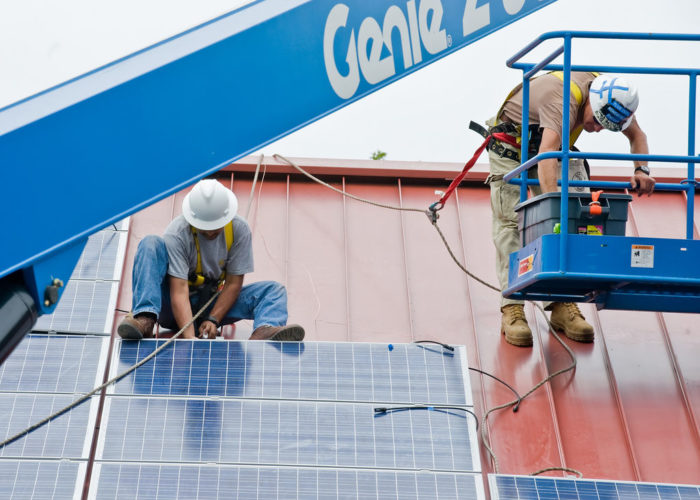
Image Credit: Wikimedia Commons/Alex Snyder
Beginning this fall, some veterans who are leaving active military duty will be able to get training at one or more military bases to become solar installers, the White House said.
The effort is part of the U.S. Department of Energy’s SunShot Instruction Training Network, which hopes to train 50,000 installers of photovoltaic (PV) systems by 2020.
SunShot already supports training centers around the country. The White House announcement wasn’t specific about where the veteran training would take place, but said SunShot would partner with as many as three military bases to create a pilot program for veterans this fall.
“The new training project will connect up to 30 motivated, tech-savvy military personnel at each base with SunShot-supported accredited solar training institutions,” the announcement said. “Ultimately, lessons learned from this first successful pilot will enable the Energy Department and military branches to expand solar training access to interested veterans, tapping into the Department’s nearly 400 solar training partner institutions nationwide.”
The announcement came in advance of the United Nations summit on climate change last month. Other initiatives in the absence of congressional action on climate change include a $70 million program by the Department of Agriculture to pay for 540 renewable energy projects in rural areas, and stricter efficiency standards for air conditioners, the Associated Press reports.
Will there be a surplus of installers?
Training will cover panel installation, connecting PV systems to the grid, and how to comply with local building codes. Solar installers Vivint Solar, SolarCity, and SunPower all have pledged to interview graduating military trainees for jobs, the White House said.
According to the Bureau of Labor Statistics, the median pay for a solar installer was $18.22 per hour, or $37,900 a year, in 2012.
In 2012, there were jobs for 4,800 PV installers in the U.S. The field was expected to grow by 24 percent by 2022, more than twice as fast as the average for all occupations. But because the field is still relatively small, that would result in only 1,200 new jobs for installers over the 10-year period, the bureau said.
It looks as if there would be many more trained installers than jobs. But one government official said the discrepancy might be explained by the Bureau of Labor Statistics’ narrow definition of the position. Other solar jobs would be available in related areas, such as electricians or construction workers.
The bureau also said the long-term outlook for job growth depends on government incentives and PV costs, among other things. A key incentive, the 30 percent federal income tax credit on solar and other renewable systems, is now scheduled to expire at the end of 2016.
Weekly Newsletter
Get building science and energy efficiency advice, plus special offers, in your inbox.











0 Comments
Log in or create an account to post a comment.
Sign up Log in